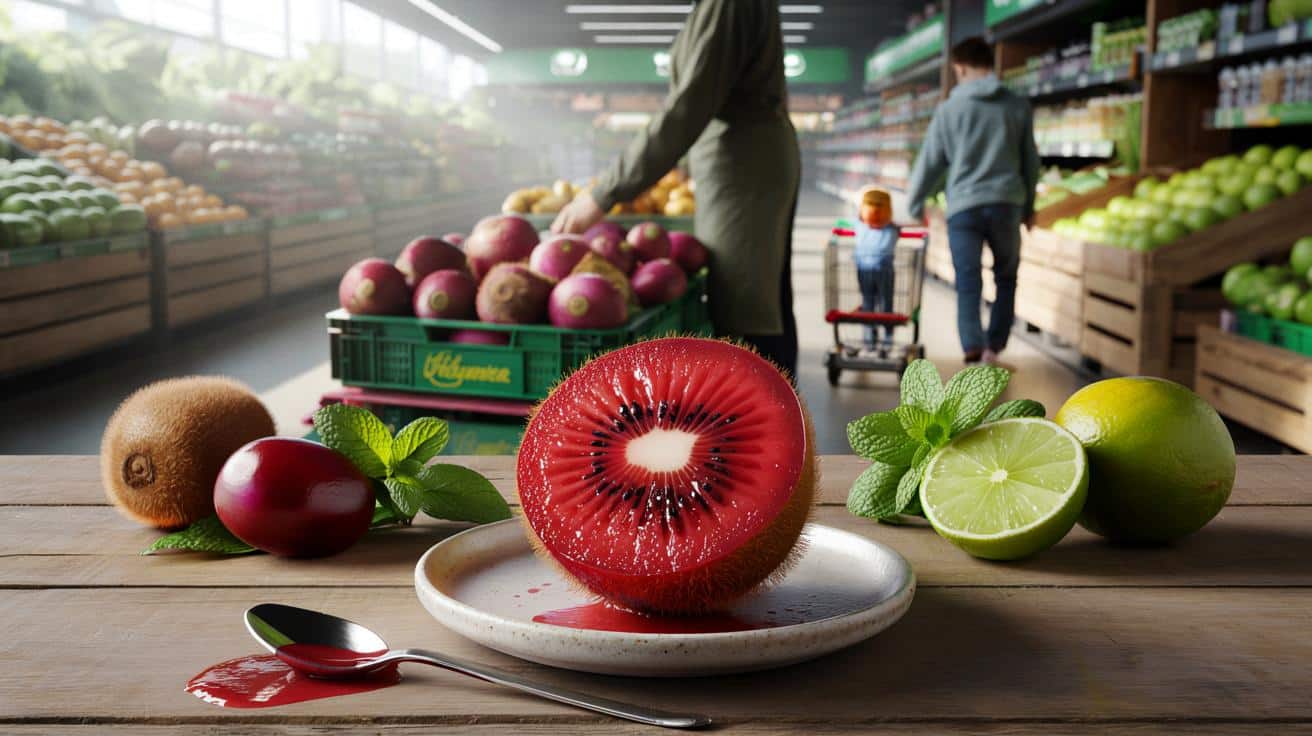A hand-written sign says “new variety” and shoppers slow down, scanning for clues. The question starts forming before you’ve even picked one up. Is it worth swapping the usual for something you’ve never tried?
The crate landed just after 8am, and the produce team still smelled faintly of wet cardboard and cold air. A young dad paused with his toddler, both peering at the cut sample laid out on a white paper plate. The flesh wasn’t the everyday green. It pulled you in like a stop sign. I took a spoon, scooped a taste, and felt the room narrow to a single, bright flavour. It wasn’t just sweet; it was berry-sweet, with a soft lift of citrus at the end. A small queue began to form by the fruit scales. It wasn’t green.
A newcomer with a blush
UK supermarkets are quietly rolling out a red‑fleshed kiwifruit, a cousin of the classic that looks almost shy until you slice it open. On the shelf it reads like a kiwi with a sunburn, but inside it carries a crimson starburst and a gentler bite. Staff tell me the first trays vanish by mid‑morning in busy stores. **Limited season** is the phrase I keep hearing, which is retail speak for “grab two now and decide later.” The mood around the crate feels like early blackberries in June. Curious, a little giddy, and not at all routine.
One shopper I met, a nurse on a late shift, tucked a pack into her basket with a grin. Her plan was simple: half for breakfast with yoghurt, half frozen for smoothies on Friday. She’d tried them on a city break and never found them again at home. *That first spoonful, she said, made her think of strawberries and sherbet.* A checkout operator chimed in from the next till. Kids take to the sweeter, berry‑leaning note faster than the tangy green. It’s a small thing in a big week, but small things add up.
So why here, and why now? Breeders and growers have been nudging flavour and colour forward for years, selecting vines that offer a deeper blush and softer acidity. Retailers love a story they can fit on a shelf‑edge label, and a fruit that looks familiar yet photographs like a jewel is an easy sell. Supply is still tight, arriving in waves from growers in warmer pockets before the British frost has fully lifted. **New fruit variety, genuine novelty, limited windows** — that mix keeps interest high and waste low, which is the quiet calculus behind many of these launches.
How to buy it, eat it, love it
Pick with your fingertips, not your eyes. Choose fruit that yields very slightly to a gentle press near the stem, like a ripe avocado without the drama. If it’s firm, let it sit on the counter for a day or two beside bananas to nudge it along, then shift to the fridge once it hits its sweet spot. The simplest method is still the most joyful: cut in half and scoop with a teaspoon. If you’re packing a lunchbox, slice into rounds and keep them snug in a lidded pot to hold the juice.
Don’t peel away the fun. The thin skin is edible and a little tangy, especially once the fruit softens. Cold dulls sweetness, so bring it out of the fridge ten minutes before eating if you can. Let’s be honest: nobody really does that every day. If you’re mixing into a fruit salad, add it last and avoid a heavy splash of lemon — you want the berry notes to sing, not fight. We’ve all had that moment when a promising fruit gets drowned in good intentions and ends up tasting like nothing.
Think beyond breakfast and you’ll get more bang for the premium.
“We sample it next to strawberries and raspberries, and people instantly get it,” says Maya Hughes, a produce buyer in London. “It’s softer than green kiwi, more perfumed, and it behaves beautifully in chilled desserts.”
Try quick maceration with a spoon of sugar for ten minutes, then drape over pound cake or pancakes. Or dice into a salsa for grilled halloumi and flatbreads.
- Best pairings: vanilla yoghurt, lime zest, mint, toasted coconut.
- Quick wins: fold into overnight oats; blitz into a 30‑second smoothie; slice over ricotta on hot toast.
- Keep it happy: countertop to ripen, fridge to hold, room temp to serve.
- Waste‑less idea: freeze slices on a tray, bag once solid for no‑clump smoothies.
Why this little red centre matters
This isn’t just a pretty cross‑section. It’s a snapshot of where British shopping is drifting: small indulgences that cut through the noise, healthier treats that feel new, and flavours we can explain to a child in one sentence. The red‑fleshed kiwi is a test balloon for growers and buyers who want better taste without scaring off regulars. **Sweet‑berry taste, simple prep, short season** — that’s the trifecta. You’ll see more fruit like this: familiar silhouettes with deeper colour, tighter seasons, and stories attached. Share a spoon with a friend and the pitch writes itself. The only tricky bit is stopping at one half.
| Key point | Detail | Interest for readers |
|---|---|---|
| Season window | Arrives in short bursts, then gone until the next wave | Encourages try‑now behaviour and reduces choice paralysis |
| Flavour profile | Berry‑leaning sweetness with a soft citrus lift | Makes it easy to swap for desserts or sweet snacks |
| Kitchen uses | Halves with a spoon, quick salsas, freezer‑friendly slices | Low‑effort ideas for breakfasts, bakes, and smoothies |
FAQ :
- What exactly is the new fruit variety?A red‑fleshed kiwifruit, a close relative of the green kiwi, bred for a rosy centre and a sweeter, berry‑like flavour.
- Where can I buy it in the UK?Major supermarkets are receiving limited batches in selected stores, often flagged on the shelf as a new or seasonal variety.
- When is it available?In short seasonal windows, typically arriving in waves during the cooler months and selling through quickly.
- How do I know it’s ripe?Press gently near the stem; it should give slightly. Keep firm fruit at room temperature, then chill to hold once ripe.
- Is it genetically modified?No. These varieties are developed through conventional breeding and selection, focusing on flavour, colour, and texture.









